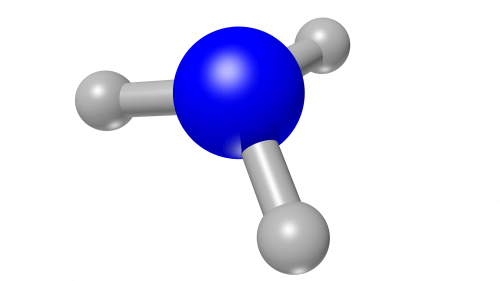Researchers have used their knowledge of XNUMXD nanomaterials to develop a 'green' method for small-scale ammonia synthesis

[Translation by Dr. Nachmani Moshe]
Researchers from Rice University have succeeded in developing an inorganic method for the synthesis of ammonia, a method that is both environmentally friendly and allows the production of the important chemical on demand and under mild conditions.
The lead researcher, Jun Lou, took advantage of the properties of a two-dimensional crystal he knows well - molybdenum disulfide - and turned it into a catalyst by removing sulfur atoms from the lattice structure of the crystal while replacing the metal molybdenum with cobalt. This substitution allowed the material to mimic the organic process used by bacteria in nature to convert atmospheric nitrogen into ammonia within organisms, including humans, who use ammonia to aid liver function. The inorganic process will enable the production of ammonia wherever it is required in the industry as a small-scale additive, when ammonia itself is produced in the chemical industry in millions of tons each year through the well-known Haber-Bosch type process. The research has long been published in the scientific journal Journal of the American Chemical Society. The wild-bush process produces a considerable amount of carbon dioxide and consumes a lot of energy," says one of the researchers. "In contrast, our process uses electricity to initiate the catalyst's activity. This electricity can be obtained from renewable energy sources, such as sunlight or wind."
![The original material (left) containing molybdenum, compared to the new material (right) containing cobalt. [Courtesy of Rice University researchers]](https://www.hayadan.org.il/images/content3/2020/01/ja9b02501_00071.gif)
The researchers obtained samples of the nanoscale material by growing damaged molybdenum disulfide crystals on carbon fibers while adding cobalt (the crystals are actually a two-dimensional structure, but they appear as a plane of molybdenum atoms with layers of sulfur atoms below and above this plane). When a current is passed through this material, the compound manages to produce more than ten grams of ammonia every hour using one kilogram of the catalyst.
"The scale is not comparable and not competitive relative to well-known industrial processes, but it can be used as an alternative in some cases," explains the lead researcher. "Our process will enable the local and immediate production of ammonia in places where there are no suitable plants, and even in space applications." The researchers explain that although nitrogen is used in the laboratory for this purpose, the process can be easily adjusted so that it can utilize the abundant nitrogen in the air.
The researchers believe that additional doping materials, besides cobalt, will also allow other chemicals to be catalyzed, a whole topic for future research in this field. "We thought that a golden opportunity had come our way to take something very familiar to us and try to imitate what nature has been doing for billions of years," the researcher explains. "If we manage to plan an appropriate backup, our process will be able to perform its important function without interruptions and efficiently."

3 תגובות
To the anonymous who responded to what I wrote here,
I invite you to enter my website about animal abuse below.
You have nothing to lose, at most you will learn something new.
Don't act like a troll, I'm sure you're a good person with high potential.
I also wrote my email here if you want to continue chatting.
A bit about how we abuse the animals on my website
https://eisaak123.wixsite.com/animals
Eli Isaac eisaak123@gmail.com
An outstanding lecturer at the university and a senior software engineer with a master's degree in computer science
Academic level private tutor
Private tutor Android Private tutor Assembler Private tutor java
Private teacher ++c Private teacher Python Private teacher #c
Private computer science tutor Private tutor React Private tutor javascript
https://eisaak123.wixsite.com/privatelessons
Response to Eli Maizek, you wrote nonsense about the juice of animal secretions, the treatment and refining of the waste water will cost more than production with the specified method (what's more, the estimated cost of the facility will be many times more expensive per ton of production) compared to the Bosch-Haber method!!
The extent of your response is teacher teacher.... Unnecessary is not on the right site!
Now I will fire up my charcoal grill and make a smoked beef steak with ammonia sauce
Why not get ammonia in an easier way?
Many millions of animals in the meat and dairy industry are raised in high density and excrete urine and feces
On the floor. These secretions raise ammonia vapors that cause damage to the animals' respiratory tract and lungs
theirs and cause them to have impaired vision to the point of blindness.
Why not simply remove the ammonia vapors (pump them out) and along the way also prevent them
Great distress from these poor animals turned by humanity
for objects (object) in order to save every shekel in the meat industry within
Severe animal abuse.
See more details in my link below.
A bit about how we abuse the animals on my website
https://eisaak123.wixsite.com/animals
Eli Isaac
Private tutor Android Private tutor Assembler Private tutor java
Private teacher ++c Private teacher Python Private teacher #c
Private computer science tutor Private tutor React Private tutor javascript
https://eisaak123.wixsite.com/privatelessons